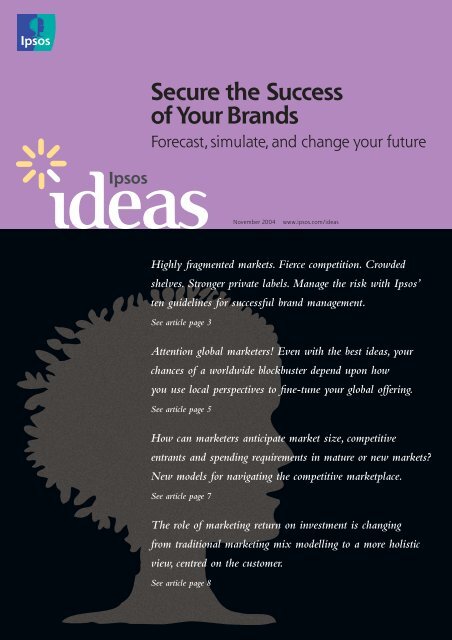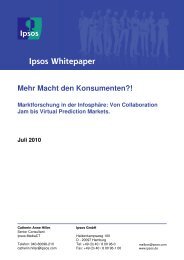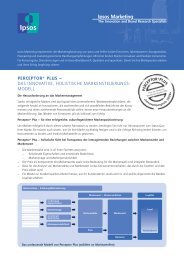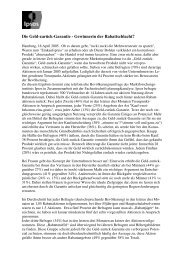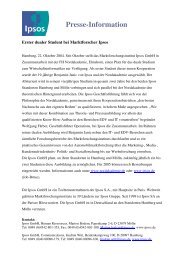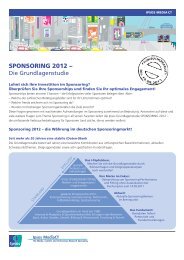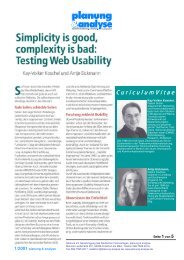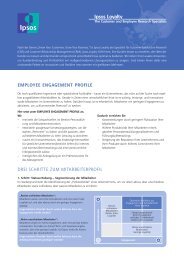Secure the Success ofYourBrands
Secure the Success ofYourBrands
Secure the Success ofYourBrands
You also want an ePaper? Increase the reach of your titles
YUMPU automatically turns print PDFs into web optimized ePapers that Google loves.
<strong>Secure</strong> <strong>the</strong> <strong>Success</strong><br />
of Your Brands<br />
Forecast, simulate, and change your future<br />
November 2004 www.ipsos.com/ideas<br />
Highly fragmented markets. Fierce competition. Crowded<br />
shelves. Stronger private labels. Manage <strong>the</strong> risk with Ipsos’<br />
ten guidelines for successful brand management.<br />
See article page 3<br />
Attention global marketers! Even with <strong>the</strong> best ideas, your<br />
chances of a worldwide blockbuster depend upon how<br />
you use local perspectives to fine-tune your global offering.<br />
See article page 5<br />
How can marketers anticipate market size, competitive<br />
entrants and spending requirements in mature or new markets?<br />
New models for navigating <strong>the</strong> competitive marketplace.<br />
See article page 7<br />
The role of marketing return on investment is changing<br />
from traditional marketing mix modelling to a more holistic<br />
view, centred on <strong>the</strong> customer.<br />
See article page 8
2 Ipsos Ideas<br />
Differences and Bridges Between<br />
Datamining and Sociology By Jean-Marc Lech<br />
The sociologist’s profession is <strong>the</strong><br />
most wonderful in <strong>the</strong> world. And<br />
without doubt one of <strong>the</strong> two oldest.<br />
That is because it is a paparazzo<br />
job: it is a question of seeing everything,<br />
and telling everything –<br />
without ever being seen oneself.<br />
Writing thousands of questions,<br />
<strong>the</strong>mselves submitted to tens of<br />
thousands of people for answers,<br />
<strong>the</strong> sociologist looks for angles from<br />
which to take his photographs, and<br />
variables to explain <strong>the</strong>ir development.The<br />
sociologist thinks of<br />
himself as a film producer.The<br />
distance between him and <strong>the</strong> people<br />
he questions is reassuring to him:<br />
he speaks in terms of social classes,<br />
age groups, and political tendencies.<br />
It is easy to see that <strong>the</strong> sociologist<br />
likes cover and that, in him, courage<br />
is purely intellectual. So he dreams<br />
of variables and <strong>the</strong>ir relations:<br />
Does divorce predispose subjects to<br />
suicide? Is absenteeism at work<br />
greater in women than in men?<br />
The questions asked in <strong>the</strong> 1960s<br />
first gripped <strong>the</strong> public’s attention<br />
and <strong>the</strong>n waned.Then came multivariate<br />
analysis: new variables<br />
were introduced into <strong>the</strong> original<br />
two-variable relationship – and<br />
<strong>the</strong>ir effects were examined.<br />
The annoying thing is that we see<br />
better without understanding more.<br />
And so <strong>the</strong> sociologist is tempted<br />
by <strong>the</strong> vision of real life. Qualitative<br />
studies and focus groups offer just<br />
such delights.You can stay a voyeur<br />
thanks to <strong>the</strong> benefits of observing<br />
through a one-way mirror, and you<br />
can watch and listen to consumers<br />
or voters.<br />
This initial temptation – which moves<br />
from <strong>the</strong> analysis of social groups<br />
to that of individuals speaking in<br />
groups – is ultimately unsatisfying.<br />
You think you immediately understand<br />
what you see because you<br />
have heard it. And <strong>the</strong>n <strong>the</strong> sociologist<br />
becomes wary of <strong>the</strong> illusion<br />
of transparency and <strong>the</strong> frustrated<br />
temptation of immediate knowledge.<br />
Caught in <strong>the</strong> heady paradox of<br />
quantitative analysis, disturbed by <strong>the</strong><br />
too-transient pleasure of spying on<br />
focus groups, might <strong>the</strong> sociologist<br />
discover satisfaction by becoming<br />
an engineer? After Emile Durkheim<br />
and Max Weber, after Uncle Freud<br />
and Cousin Bourdieu, <strong>the</strong>re is still<br />
<strong>the</strong> master Gaston Bachelard;<br />
yes, <strong>the</strong> engineer tempts us if he<br />
allows us to embrace both <strong>the</strong><br />
observations of <strong>the</strong> first level<br />
(empirical approach) and those of<br />
<strong>the</strong> second (applied rationalism).<br />
After all, <strong>the</strong> original meaning of<br />
engineer was a builder of engines<br />
of war. But <strong>the</strong> war now is one<br />
of models.The model that predicts<br />
without being reductionist<br />
will remain <strong>the</strong> sociologist’s<br />
ultimate pleasure.<br />
About Ipsos Ideas<br />
Ipsos Ideas is published by Ipsos,<br />
a leading global survey-based market<br />
research company. Current and past issues<br />
of Ipsos Ideas are available at<br />
www.ipsos.com/ideas.<br />
To receive a free email subscription,<br />
to send us your comments or questions,<br />
or to unsubscribe to <strong>the</strong> newsletter,<br />
please email charlotte.vigne@ipsos.com<br />
or write us at:<br />
Ipsos Ideas<br />
Communications Department<br />
35 rue du Val de Marne<br />
75013 Paris cedex 13, France<br />
Tel: +33 1 41 98 90 00<br />
Fax: +33 1 41 98 90 50<br />
Publisher<br />
Jean-Marc Lech<br />
Editorial Board Members<br />
Sandy Eubank<br />
Todd Kirk<br />
Gerardo Martinez Romano<br />
Jérome Simulin<br />
Andrew Till<br />
Ed Wolkenmuth<br />
Editorial Team<br />
Dan Maceluch<br />
Ca<strong>the</strong>rine Roussiès<br />
Charlotte Vigne<br />
Erin Williams<br />
Production<br />
Roland Clifford<br />
Barbara Day<br />
Marketing<br />
Elen Alexov<br />
Darcy Ulmer<br />
© 2004, Ipsos. All rights reserved.<br />
Jean-Marc Lech started his career as a researcher in <strong>the</strong> Institut Français d’Opinion Publique – IFOP – and became President<br />
and CEO of <strong>the</strong> company in 1980. He joined Ipsos in 1982 as Co-Chairman with Didier Truchot. As a specialist of opinion research,<br />
he has published several books on French society and political life, such as Sondages Privés.<br />
You can reach him at jean-marc.lech@ipsos.com.
Ten Guidelines for <strong>Success</strong>ful<br />
Brand Management By Sandy Eubank and Jérôme Simulin<br />
To make matters worse, most companies<br />
have <strong>the</strong> same ideas at <strong>the</strong> same time.<br />
No wonder! These companies recruit <strong>the</strong><br />
same type of people, <strong>the</strong>y use <strong>the</strong> same<br />
competitive intelligence, and <strong>the</strong>y use <strong>the</strong><br />
same research, consumer insights tools,<br />
and models to generate, screen, and forecast<br />
new marketing ideas or strategies.<br />
What can you do to stand out? Doing<br />
<strong>the</strong> same as everyone else? No way! Instead,<br />
why don’t you read <strong>the</strong>se ten guidelines<br />
for successful marketing? Now you really<br />
do have an alternative!<br />
1. Don’t be fooled by high first year<br />
volume estimates<br />
New product cemeteries are full of year<br />
one successes that failed in year two or three.<br />
This is because it is easy to buy more<br />
volume in year one with high spending, but<br />
eventually spending is cut and <strong>the</strong> brand<br />
must stand on its own strength. Experience<br />
shows that tomorrow’s successes are those<br />
brands that will sustain volume after<br />
support is gone or reduced.Therefore<br />
you need an accurate estimate of your<br />
long-term volume potential to know if<br />
your brand is really a success.<br />
2. Don’t expect too much from<br />
purchase intent<br />
Of course purchase intent is a very useful<br />
measure, since it is related to <strong>the</strong> volume<br />
of your product, but what do you do if your<br />
product doesn’t have high enough purchase<br />
intent? Purchase intent does not tell <strong>the</strong><br />
whole story: while it helps you know how<br />
strong your concept is, it does not help<br />
you know how to improve it.To create a<br />
road map for improving your concept and<br />
product, make sure you test with a system<br />
that includes both diagnostic measures that<br />
explain your brand’s performance and,<br />
based on <strong>the</strong> diagnostic measures, a model<br />
that tells you <strong>the</strong> volume behind each<br />
improvement you may want to do.<br />
3. The wrong advertising can damage<br />
your product<br />
Advertising builds your product’s positioning<br />
in consumers’ minds, and <strong>the</strong> way <strong>the</strong><br />
advertising positions your product can greatly<br />
affect its long-term sales. Experience has<br />
shown us that different ads developed from<br />
<strong>the</strong> same successful concept can produce<br />
significantly different on-going sales profiles,<br />
sometimes by as much as 30%! Before<br />
going in-market, always do a final check;<br />
verify that your advertising delivers <strong>the</strong><br />
intended positioning, fits with your<br />
products’ delivery, and truly produces <strong>the</strong><br />
targeted volume.<br />
Positioning and Ad Quality<br />
Make a Difference to Your Sales<br />
Sales Target<br />
Concept Board<br />
Source: Designor ®<br />
© Ipsos 2004<br />
Advertising 1<br />
Advertising 2<br />
4. So can <strong>the</strong> wrong packaging<br />
Today’s crowded shelves are full of<br />
packaging that might as well be invisible<br />
to consumers, particularly given <strong>the</strong><br />
trend of cutting package costs to increase<br />
profitability.Today, many manufacturers<br />
package all <strong>the</strong>ir products similarly,<br />
without realising that this strategy makes<br />
<strong>the</strong>ir individual products disappear from<br />
Ipsos Ideas<br />
Your job has never been so difficult! Today, markets are highly fragmented, competition is<br />
fierce, shelves are crowded, and private labels are stronger. On top of this, growth is limited,<br />
budgets are reduced, and short-term promotions are often <strong>the</strong> only weapon considered to<br />
grow a brand. In <strong>the</strong>se conditions, launching a new product or a line extension, or managing<br />
or restaging an existing brand, is riskier than ever before.<br />
consumers’ eyes.To be noticeable, your<br />
product needs to stand out from <strong>the</strong><br />
products immediately surrounding it on<br />
shelf. And guess what? These neighbours<br />
are very often o<strong>the</strong>r products in your<br />
own range! This is why we generally find<br />
that new line extensions have trouble<br />
generating enough visibility on shelf. Don’t<br />
forget, consumers can only buy what <strong>the</strong>y<br />
can find!<br />
The easiest way to help each product stand<br />
out is by using different visual signals<br />
such as colours, shapes, product forms, or<br />
pack formats.There is often a trade-off<br />
in volume between range coherence and<br />
item identity. When testing, make sure<br />
you can measure your product visibility to<br />
maximize your volume. For this purpose,<br />
a shelf is enough – no need to have a<br />
simulated store like twenty years ago, nor<br />
<strong>the</strong> problems that it generates.<br />
5. The wrong name can spell disaster<br />
Too often manufacturers saddle a product<br />
with a name that reduces its sales potential<br />
– it’s too long, too complicated, or does<br />
not mean anything. Sometimes this is done<br />
because companies want one name<br />
worldwide, and sometimes <strong>the</strong> name is<br />
created to fit within a complex range.<br />
Our experience shows <strong>the</strong> name can have<br />
a significant impact on volume. Getting<br />
<strong>the</strong> name right can help <strong>the</strong> product<br />
be noticed and purchased.To be successful,<br />
a brand name must be short and easy<br />
to remember. If possible, <strong>the</strong> item name<br />
should mean something in <strong>the</strong> local<br />
language, and it is even better if <strong>the</strong><br />
meaning helps reinforce <strong>the</strong> positioning<br />
or key benefits.<br />
Continued…<br />
3
4 Ipsos Ideas<br />
Ten Guidelines for <strong>Success</strong>ful Brand Management<br />
6. How you are differentiated matters<br />
more than how much you differentiate<br />
Sources differ on whe<strong>the</strong>r being different<br />
drives product success because differentiation<br />
is complicated. What really matters is<br />
being different in a way that is relevant to<br />
consumers. A tuna fish flavoured birthday<br />
cake is very different, but you won’t sell<br />
any! You need to differentiate your brand<br />
on a benefit that drives consumers’<br />
purchasing, and <strong>the</strong> more important <strong>the</strong><br />
benefit, <strong>the</strong> better. Our database shows<br />
that products that are meaningfully<br />
differentiated achieve significantly higher<br />
sales and rate of success in market.<br />
The situation is even more complicated<br />
in <strong>the</strong> case of a line extension, where you<br />
must differentiate <strong>the</strong> new item from <strong>the</strong><br />
parent brand. It needs to have a separate<br />
identity and an additional advantage to drive<br />
incremental volume to <strong>the</strong> parent, and this<br />
differentiation must be on a benefit that<br />
is relevant to <strong>the</strong> consumer, but it also<br />
needs to fit with <strong>the</strong> parent brand’s equity<br />
or it will dilute <strong>the</strong> brand.<br />
7. Don’t forget to build a true<br />
sustainable competitive advantage<br />
to your product<br />
For consumers to become loyal buyers<br />
of your product, <strong>the</strong>y need to believe it is<br />
better than <strong>the</strong> brand <strong>the</strong>y are buying<br />
today.You need to give your product an<br />
advantage in terms of emotions, performance,<br />
or value.This gives it a shield to defend<br />
itself against future competitive launches,<br />
spending, or price cuts. If you don’t create<br />
a competitive advantage, you can end up<br />
developing a category for your competitors!<br />
We’ve seen many examples where <strong>the</strong><br />
big spender of <strong>the</strong> category does not reap<br />
<strong>the</strong> full reward, and a better performing<br />
competitor benefits instead. Do you really<br />
want to support your competitors?<br />
We’re pretty sure you don’t ....<br />
In <strong>the</strong> case of a line extension, <strong>the</strong> brand<br />
consumers are buying today may be<br />
<strong>the</strong> line extension’s parent brand. In this<br />
situation, it will be critical that <strong>the</strong> new<br />
extension reinforces <strong>the</strong> brand’s heritage<br />
while bringing a new benefit to its profile.<br />
If <strong>the</strong> new line extension just provides<br />
more of what <strong>the</strong> parent’s brand already<br />
promises, <strong>the</strong>re is a big risk; this can<br />
erode <strong>the</strong> parent brand’s equity resulting<br />
in low incremental volume.<br />
8. Don’t over-price your promise<br />
Offering a good value proposition is one<br />
of <strong>the</strong> strongest drivers of long-term<br />
volume potential.To determine your product<br />
value, you need to look beyond <strong>the</strong> price<br />
data and understand how <strong>the</strong> market views<br />
your product versus your competitors’.<br />
Your price relative to competition needs to<br />
be in-line with <strong>the</strong> strength of your promise,<br />
relative to that same competition, to offer<br />
good value. It is important to remember<br />
that if your value is not optimal, you can<br />
always improve it by changing ei<strong>the</strong>r<br />
your promise or your price. Also, it helps<br />
to know if <strong>the</strong> market is price or quality<br />
driven.You need to understand all <strong>the</strong>se<br />
complex components to set <strong>the</strong> price<br />
that will maximize your sales and profit.<br />
9. Spending more is not always <strong>the</strong><br />
smartest strategy<br />
It is an accepted rule in <strong>the</strong> new product<br />
business that sampling is <strong>the</strong> best way to<br />
market an initiative that has a weak concept<br />
but is a strong product. Is this always <strong>the</strong><br />
case? Wouldn’t it be better to figure out<br />
how to improve your concept instead,<br />
and save your money? When you understand<br />
how a consumer chooses a brand and<br />
how your brand performs versus your<br />
competitors, it is easy to identify improvements<br />
that unlock <strong>the</strong> potential of your<br />
brand. Our experience shows that it’s<br />
better to refine your positioning – once<br />
you know how – than to artificially drive<br />
demand with sampling and o<strong>the</strong>r expensive<br />
push strategies.<br />
Simulations Help You<br />
Reach Your Goal More Profitably<br />
Sales Target<br />
Current Sales<br />
Forecasted As Is<br />
Source: Designor ® /Detector ®<br />
© Ipsos 2004<br />
With Higher<br />
Ad Spending<br />
With Stronger<br />
Positioning on “Health”<br />
With Sampling With Stronger<br />
Positioning on<br />
“Taste/Pleasure”<br />
10. In conclusion, to build long-term<br />
success, forecasting your sales is<br />
no longer enough<br />
You need to know <strong>the</strong> strengths and<br />
weaknesses of your product compared to<br />
its current competitors, and be able to<br />
take advantage of this knowledge to<br />
stimulate improvements that, like a shield,<br />
will protect your initiative from future<br />
unknown, competitive threats.<br />
Jérôme Simulin is responsible for <strong>the</strong> global development of Ipsos Novaction & Vantis and Deputy General Manager of <strong>the</strong> Paris-based<br />
headquarters. Ipsos Novaction & Vantis delivers consulting and model-based research. It is a market leader in simulated test markets<br />
(STM) and marketing mix modelling. Based in Paris, France, Jérôme has over 15 years of global experience in forecasting, modelling,<br />
and marketing consulting, having helped many leading consumer packaged goods and consumer health products companies with<br />
<strong>the</strong>ir innovation and core brand management strategies. Contact: jerome.simulin@ipsos-novaction.com.<br />
Sandy Eubank is Senior Vice President and General Manager of Ipsos Novaction within Ipsos Novaction & Vantis North America. Based in<br />
Norwalk, Connecticut, USA, Sandy has over 20 years of market research and marketing consulting experience, having spent <strong>the</strong> previous<br />
15 years working with BASES. During <strong>the</strong>se fifteen years, Sandy held positions in client service/sales (both USA and Internationally), general<br />
management and product development (she led <strong>the</strong> development of Pre-Bases). After ACNielsen purchased BASES in 1998, she headed<br />
<strong>the</strong> global marketing department for ACNielsen. Contact: sandy.eubank@ipsos-novaction-na.com.
Going Global, Regional, and Local<br />
International research at <strong>the</strong> crossroads By Gerardo Martinez Romano and Andrew Till<br />
Fifteen years ago, multinational companies<br />
arrived in Latin America with massive capital<br />
and investments.They moved forward swiftly,<br />
entering and expanding <strong>the</strong>ir operations<br />
by acquisitions and joint ventures both in<br />
<strong>the</strong> fast-moving consumer goods (FMCG)<br />
terrain and in durable goods and services.<br />
This triggered significant marketing activity<br />
and <strong>the</strong> launching and re-launching of many<br />
products. Marketers enjoyed <strong>the</strong> freedom of<br />
developing brand strategies attuned to local<br />
consumer tastes, and <strong>the</strong>re were propositions<br />
with similar platforms that were tested<br />
and marketed with different brand names.<br />
For example, OMO powdered detergent in<br />
Brazil had <strong>the</strong> same positioning as ALA in<br />
Argentina; Sedal shampoo in Argentina was<br />
called Seda in Brazil and Sunsilk in México<br />
and <strong>the</strong> countries in <strong>the</strong> Andean area.<br />
Procenex – a floor washing liquid – in<br />
Argentina was Veja in Brazil.The sweetener<br />
Equal in Brazil and <strong>the</strong> Andean area was<br />
called Canderel in Mexico and Nutrasweet<br />
in <strong>the</strong> rest of <strong>the</strong> continent.<br />
The Emergence of<br />
<strong>the</strong> Global Brand Strategy<br />
The 90s were characterized by <strong>the</strong> loss of<br />
local identities and brand denominations.The<br />
search for global harmonization was leaving<br />
cultural differences, habits, and <strong>the</strong> history<br />
of brands aside. But several FMCG prospects<br />
entering <strong>the</strong> region – specifically in <strong>the</strong><br />
food market – were not initially successful.<br />
In many cases, <strong>the</strong> reason for failure was <strong>the</strong><br />
marketer’s conviction that a proposition<br />
with excellent performance in its country<br />
of origin could be exported directly,<br />
without adjustments.The pressure for quick<br />
harmonization had negative consequences<br />
for some companies that neglected proper<br />
testing and evaluation.<br />
Two very famous brands were unsuccessful<br />
in introducing <strong>the</strong>ir products in Argentina,<br />
not realizing that <strong>the</strong>ir intention of making<br />
<strong>the</strong> market adopt <strong>the</strong>ir commodity without<br />
adapting <strong>the</strong> product to <strong>the</strong> culture was a<br />
mistake. For example, pizza has a great<br />
acceptance in Argentina, but Pizza Hut didn’t.<br />
In Argentina, <strong>the</strong> kind of pizza most often<br />
consumed is thin-crust, and is sold in various<br />
branded and unbranded pizza parlours at<br />
different price ranges. Pizza Hut just did<br />
not translate into <strong>the</strong> emblem of Italian pies<br />
for Argentineans.<br />
Dunkin’ Donuts is ano<strong>the</strong>r example of a<br />
highly successful brand that had poor results<br />
when exported to Argentina. Pastry shops<br />
are everywhere in Argentina; <strong>the</strong>y are very<br />
cheap, and <strong>the</strong> preferred treats are croissants<br />
and o<strong>the</strong>r creamy patisserie products, which<br />
are perceived as much less cloying and far<br />
tastier than donuts. Donuts couldn’t compete<br />
with <strong>the</strong> historic and cultural significance<br />
of Argentina’s pastry shops.<br />
Today Ipsos Novaction &Vantis partners<br />
with our multinational clients to understand<br />
<strong>the</strong> unique perceptual compositions of<br />
local Latin American markets and make<br />
<strong>the</strong> necessary adjustments for launching<br />
successful global propositions.We identify<br />
<strong>the</strong> proper mix of global attractiveness and<br />
local flavour to give our clients’ brands an<br />
early advantage. Our forecasting and modelling<br />
products combined with our local<br />
expertise in analyzing diagnostics and our<br />
understanding of <strong>the</strong> beneficial drivers of<br />
each market have been successful at identifying<br />
<strong>the</strong> keys to local marketing success.<br />
Our studies continue to demonstrate that<br />
what brea<strong>the</strong>s life and success into new<br />
products are stimulating and creative ideas<br />
about target markets, <strong>the</strong>ir needs, <strong>the</strong>ir<br />
culture, and <strong>the</strong>ir behaviour, that are all<br />
locally oriented.<br />
Thus <strong>the</strong> marketing challenge is to transform<br />
global strategy into regional execution in<br />
an environment where tougher competitive<br />
climates are developing in many countries,<br />
global competitors are learning how to<br />
locally plan and launch, and where technology<br />
and new consumer data availability on a<br />
country-by-country basis is also improving.<br />
Winning marketers recognize and understand<br />
<strong>the</strong> differences in consumer key drivers on<br />
a market-by-market basis and make adjustments<br />
to <strong>the</strong>ir global business strategies<br />
to capitalize on regional distinctions.<br />
Ipsos Ideas<br />
Attention global marketers! Even with <strong>the</strong> best ideas, your chances of a worldwide<br />
blockbuster depend upon how you use local perspectives to fine-tune your global offering.<br />
From Simple Connections Spring<br />
Magnificent Ideas<br />
How does <strong>the</strong> marketer take advantage?<br />
With local market expertise, insight and<br />
observational data, marketing diagnostics,<br />
and perceptual modelling that can produce<br />
simulations and maps of consumer behaviour<br />
to guide marketers on <strong>the</strong> optimal new<br />
product strategies and actions at <strong>the</strong> country<br />
level.This link between local expertise,<br />
consumer market research, and modelling<br />
is necessary to win.<br />
In <strong>the</strong> consumer electronics industry, <strong>the</strong><br />
new flat-screen TV is starting to experience<br />
phenomenal growth as it expands on a<br />
worldwide basis. Ipsos Novaction & Vantis<br />
has supported one European brand’s success<br />
in launching <strong>the</strong>ir flat-screen TV by<br />
identifying <strong>the</strong> consumer drivers that are<br />
common across different countries in Europe<br />
and <strong>the</strong> rest of <strong>the</strong> world.We also simulated<br />
how <strong>the</strong> brand can be even more successful<br />
by customizing its design and promotional<br />
activities to local country tastes.<br />
Ipsos Novaction & Vantis not only identified<br />
<strong>the</strong>se different drivers of brand choice<br />
by country, but also simulated and forecasted<br />
sales based upon planned marketing and sales<br />
campaigns in each country. For this client,<br />
it was important to know when to launch,<br />
how to position <strong>the</strong> product, and, critically,<br />
how to make its marketing efforts successful<br />
in building <strong>the</strong> brand on a global platform.<br />
Through <strong>the</strong> ability to predict what will<br />
happen with <strong>the</strong>ir product launch or<br />
relaunch, marketers are using our analyses<br />
and local expertise to bring innovative and<br />
profitable ideas to <strong>the</strong> market. This practice is<br />
accelerating because of improved technology<br />
(in data and computer modelling) that can<br />
be integrated into <strong>the</strong> innovation and launch<br />
processes, where <strong>the</strong> needs to be calculated<br />
and time to market is critical; because of<br />
greater precision in local markets and<br />
consumer behaviour is available; because<br />
<strong>the</strong>re is increased access to more data and<br />
information; and because of <strong>the</strong> speed<br />
and precision in forecasting and modelling.<br />
Continued…<br />
5
6 Ipsos Ideas<br />
Going Global, Regional, and Local International research at <strong>the</strong> crossroads<br />
A Global Case Study<br />
Ipsos Novaction &Vantis worked with<br />
a multinational client on <strong>the</strong> global rollout<br />
of a shampoo that had been developed<br />
in Europe, where it enjoyed some success.<br />
We tested <strong>the</strong> marketing mix and modelled<br />
sales for <strong>the</strong> shampoo in 17 countries<br />
around <strong>the</strong> world.<br />
An Idea with Global Appeal<br />
It was found that <strong>the</strong> brand’s functional core<br />
concept was highly relevant to consumers<br />
when compared with <strong>the</strong> competition<br />
in each respective country. In 13 out of 17<br />
countries tested, <strong>the</strong> new concept was<br />
significantly more relevant than an average<br />
new shampoo.This was a highly encouraging<br />
start for <strong>the</strong> global rollout!<br />
New Shampoo: Concept Relevance<br />
Test concept relevance index versus market<br />
leader in each country<br />
Spain<br />
Taiwan<br />
U.K.<br />
Greece<br />
Hong Kong<br />
Thailand<br />
Japan<br />
New Zealand<br />
Australia<br />
France<br />
Singapore<br />
Malaysia<br />
Brazil<br />
Finland<br />
Argentina<br />
Germany<br />
Italy<br />
Mexico<br />
Source: Designor<br />
© Ipsos 2004<br />
®<br />
Average New Shampoo<br />
Unfortunately, performance in terms of trial<br />
purchase rates and sales potential proved<br />
to be much more variable in <strong>the</strong> simulated<br />
test markets, even taking <strong>the</strong> differences in<br />
market permeability into account.This was<br />
surprising, given that <strong>the</strong> basic idea seemed<br />
to transport so well across borders. Clearly<br />
consumers were discriminating in deeper<br />
ways, ways that were being played out both<br />
at <strong>the</strong> regional and local country levels.<br />
Regional Psychologies<br />
Ipsos Novaction & Vantis’ perceptual<br />
modelling tool, Perceptor, ® uncovered significant<br />
regional differences in how consumers<br />
process <strong>the</strong>ir impressions of shampoo brands.<br />
In Europe, consumers were generally<br />
found to link <strong>the</strong>ir expectation of gaining<br />
an end-benefit of beautiful hair to <strong>the</strong>ir<br />
perception of <strong>the</strong> shampoo’s functionality.<br />
This favoured <strong>the</strong> test brand, as it had a<br />
highly functional claim. For Asians, however,<br />
functionality and beautiful hair were seen to<br />
be completely separate ideas, different key<br />
drivers of brand preference. For <strong>the</strong> brand to<br />
be successful in Asia, it could not rely on<br />
functionality to drive perception of beauty.<br />
Ultimately, <strong>the</strong> performance of this brand<br />
in Asian markets was found to depend upon<br />
<strong>the</strong> degree to which its advertising execution<br />
communicated <strong>the</strong> local expression of<br />
beautiful hair. A TV ad was developed in<br />
Thailand.The Bangkok team used local<br />
qualitative insight to arrive at a fancy creative<br />
concept.The highly symbolic creative<br />
was aimed at linking <strong>the</strong> new shampoo’s<br />
functional claim with <strong>the</strong> more emotive<br />
end-benefit of beautiful hair, <strong>the</strong> exact<br />
linkage that didn’t exist for Asians in<br />
<strong>the</strong> way it did for Europeans.<br />
The TV ad matched or exceeded <strong>the</strong><br />
perceived functionality of a strong, established<br />
competitor in all markets tested across<br />
<strong>the</strong> region. However, in terms of beauty,<br />
Perceptor showed that <strong>the</strong> symbolic creative<br />
worked very well for Thai consumers, but<br />
<strong>the</strong> response in o<strong>the</strong>r countries was mixed.<br />
The ad was just acceptable in <strong>the</strong><br />
neighbouring markets of Malaysia and<br />
Singapore, but it failed to generate competitive<br />
perceptions in <strong>the</strong> North East Asian<br />
markets of Japan,Taiwan, and Hong Kong.<br />
The test results were later validated by<br />
market performance: only in <strong>the</strong> Thailand<br />
did <strong>the</strong> brand enjoy long-term success<br />
in terms of sales and it even became a major<br />
player, but in <strong>the</strong> rest of <strong>the</strong> region <strong>the</strong><br />
brand struggled.<br />
New Shampoo: Score on <strong>the</strong><br />
Dimension “Beautiful Hair”<br />
70<br />
60<br />
50<br />
40<br />
30<br />
20<br />
10<br />
0<br />
-10<br />
-20<br />
Competitor<br />
© Ipsos 2004<br />
Test<br />
Thailand Singapore Japan Malaysia<br />
Source: Designor ® /Perceptor ®<br />
Taiwan<br />
Hong<br />
Kong<br />
Think Global and Think Regional<br />
and Think Local<br />
The above example highlights how success<br />
for a concept with proven global appeal can<br />
be dependant upon understanding regional<br />
needs and addressing <strong>the</strong>m in a way appropriate<br />
to each country. This is a challenge for multinational<br />
companies, and <strong>the</strong> winners in<br />
<strong>the</strong> global marketplace will be those organizations<br />
with integrated teams, that work<br />
effectively toge<strong>the</strong>r on three levels: global,<br />
regional, and local. It’s also why our own<br />
Ipsos Novaction &Vantis client teams<br />
are structured to deliver global coordination,<br />
regional excellence and local expertise.<br />
Andrew Till is a Director for <strong>the</strong> Asia Pacific Region and is based at Ipsos Novaction & Vantis regional headquarters in Japan. Andrew<br />
has over 17 years experience with Ipsos Novaction, most of which has focused on <strong>the</strong> Asia-Pacific region. He has held positions managing<br />
both analysis and client service teams. In <strong>the</strong> late 80s and early 90s, he worked on <strong>the</strong> introduction of <strong>the</strong> first simulated test marketing<br />
(STM) into <strong>the</strong> emerging markets of South East Asia and China. Since <strong>the</strong>n, he has been involved in over 1,000 market-modelling projects<br />
in <strong>the</strong> region, mainly for multinational manufacturers of consumer packaged goods. Contact: andrew.till@ipsos-novaction.com.<br />
Gerardo Martinez Romano is Director of Ipsos Novaction & Vantis Argentina and regional coordinator for Ipsos Novaction & Vantis in<br />
Latin America. Gerardo has been with Ipsos in Argentina since 1996. Before that, he held senior market research management positions<br />
with major Argentina-based multinational companies, such as Unilever, Kraft Suchard Argentina, and Gillette.<br />
Contact: gerardo.martinez-romano@ipsos.com.ar.
Strategic Anticipation of<br />
Product <strong>Success</strong> By Ed Wolkenmuth<br />
Ask any brand manager, ei<strong>the</strong>r of a mature<br />
brand or a new brand, what is <strong>the</strong>ir greatest<br />
fear in managing <strong>the</strong> success of <strong>the</strong>ir brand.<br />
Most managers will not answer “an increase<br />
in competitive spending (advertising or<br />
promotion),” nor “competitive price reduction.”<br />
They will respond “<strong>the</strong> launch of a<br />
new brand into my category often times has<br />
<strong>the</strong> greatest impact on my brand’s market<br />
share.” Ipsos Novaction &Vantis are coaching<br />
brand managers in all <strong>the</strong> major global<br />
regions on how to develop successful<br />
strategies for anticipating and navigating<br />
this competitive landscape.<br />
Emerging Markets<br />
Let’s first take a look at strategic anticipation<br />
as it relates to managing <strong>the</strong> launch of a<br />
new brand – even more exciting, launching<br />
a new brand in an emerging category.<br />
(Microwaveable entrees, aseptic packaged<br />
juices, wine coolers, MP3 players, and<br />
perhaps <strong>the</strong> electric automobile were – or<br />
are – examples of emerging markets, in<br />
<strong>the</strong>ir time.) At <strong>the</strong> earliest stages of <strong>the</strong><br />
innovation process, <strong>the</strong> corporation assigns<br />
priority to <strong>the</strong> development of new products<br />
as result of opportunity assessment.<br />
Internal assessment:<br />
• What are our core competencies that<br />
support market entry?<br />
External assessment:<br />
• What might be <strong>the</strong> eventual size of this<br />
emerging market at maturity?<br />
• Who might enter <strong>the</strong> market? When?<br />
• How strong might our point of<br />
difference be from each competitor?<br />
• What is <strong>the</strong> marketing capital required to<br />
compete effectively?<br />
For truly new emerging markets it is<br />
difficult to find meaningful secondary data.<br />
What is <strong>the</strong> corporation to do to strategically<br />
anticipate market size, competitive entrants,<br />
and spending requirements?<br />
Today, most corporations rely on market<br />
research for answers to <strong>the</strong>se questions.<br />
Unfortunately, we sometimes observe <strong>the</strong><br />
corporation being misguided.This point is<br />
best illustrated by an example taken from<br />
<strong>the</strong> wine cooler market.Various brands of<br />
this ready-to-drink alcoholic beverage still<br />
exist in most global markets.Two decades<br />
ago, <strong>the</strong> wine cooler market suddenly<br />
emerged, virtually overnight.We can trace<br />
<strong>the</strong> origin for this global business to<br />
California. It was quite trendy to mix real<br />
juice with sparkling water to create a<br />
refreshing beverage. An entrepreneurial team<br />
in <strong>the</strong> wine-producing region of California<br />
soon launched <strong>the</strong> first alcoholic wine<br />
cooler, branded California Cooler. Market<br />
research encouraged <strong>the</strong> team to launch <strong>the</strong><br />
brand and profit-eager investors to contribute<br />
capital. Market research had identified<br />
exceptionally strong measures of consumer<br />
purchase interest and investors expected<br />
great return on <strong>the</strong>ir investment. However,<br />
E. J.Gallo (Bartles & Jaymes) and Seagram’s<br />
soon entered <strong>the</strong> market with <strong>the</strong>ir own<br />
products and captured most of <strong>the</strong> market<br />
share.Was <strong>the</strong>re any strategic anticipation<br />
by <strong>the</strong> California Cooler investors?<br />
Modelling Strategic Anticipation<br />
Ipsos Novaction &Vantis has developed<br />
accurate market simulation models that<br />
guide companies in developing successful<br />
strategies for navigating <strong>the</strong> competitive<br />
marketplace.These models were developed<br />
by analyzing <strong>the</strong> database of more than<br />
8,000 new product introductions and<br />
examining how market share is impacted<br />
when additional brands enter <strong>the</strong> category.<br />
A significant finding is <strong>the</strong> overwhelming<br />
evidence that traditional market research<br />
measures fail to predict brand success in<br />
emerging markets.While California Cooler<br />
scored extremely high with respect to <strong>the</strong><br />
consumer’s interest to buy, Bartles & Jaymes<br />
and Seagram’s also scored equally high.<br />
Yet <strong>the</strong>ir market shares are not very similar.<br />
Ano<strong>the</strong>r significant finding is <strong>the</strong> high<br />
correlation between a brand’s market share<br />
and <strong>the</strong> contribution of <strong>the</strong> following three<br />
factors: (1) <strong>the</strong> brand’s order of entry into<br />
<strong>the</strong> category; (2) <strong>the</strong> marketing intensity<br />
for <strong>the</strong> brand; and (3) <strong>the</strong> relative point of<br />
Ed Wolkenmuth is President and COO of <strong>the</strong> Ipsos Novaction & Vantis<br />
North America unit and is responsible for managing Novaction and Vantis.<br />
Founder of <strong>the</strong> Vantis division, Ed has 30 years experience working with<br />
various industries in marketing, market research, forecasting and modelling.<br />
Contact: ed.wolkenmuth@ipsos-vantis.com.<br />
difference between <strong>the</strong> brand and o<strong>the</strong>r<br />
competitors (as measured by market research).<br />
The following chart illustrates <strong>the</strong><br />
overwhelming importance of time to market.<br />
A brand’s market share is significantly<br />
influenced by being first, second, third, etc.,<br />
to market.Therefore, <strong>the</strong> strategic anticipation<br />
of one or two strong competitors<br />
pre-empting your brand into market, or<br />
following your brand into market, can be<br />
accurately forecasted.<br />
Market Share Declines as<br />
New Brands Enter<br />
Category Growth<br />
100%<br />
Share<br />
First<br />
Entry<br />
© Ipsos 2004<br />
37%<br />
Share<br />
63%<br />
Share<br />
Second<br />
Entry<br />
18%<br />
Share<br />
30%<br />
Share<br />
52%<br />
Share<br />
Third<br />
Entry<br />
9% Share<br />
16%<br />
Share<br />
28%<br />
Share<br />
47%<br />
Share<br />
Fourth<br />
Entry<br />
Order of Brand Entry<br />
Ipsos Ideas<br />
5% Share<br />
8% Share<br />
15%<br />
Share<br />
27%<br />
Share<br />
45%<br />
Share<br />
Fifth<br />
Entry<br />
In this example of <strong>the</strong> wine cooler category,<br />
California Cooler was first to market. If<br />
order of entry is all that matters, California<br />
Cooler should have retained approximately<br />
50% market share after Bartles & Jaymes<br />
and Seagram’s entered <strong>the</strong> market.We know<br />
this was not <strong>the</strong> case.When modelling<br />
strategic anticipation, one must also consider<br />
marketing intensity. E. J. Gallo (Bartles &<br />
Jaymes) and Seagram’s, having large marketing<br />
budgets and strong retailer relationships,<br />
were able to out-market California Cooler,<br />
which had limited investor capital. Ipsos<br />
Novaction &Vantis market simulation models<br />
integrate how a brand will respond to marketing<br />
spending, as well as <strong>the</strong> order of entry<br />
phenomena and relative point of difference<br />
(from market research) to help businesses<br />
understand why a new brand is successful.<br />
Defending in Mature Markets<br />
Modelling strategic anticipation is equally<br />
important when defending your brand<br />
against new entrants in mature markets. For<br />
example, consider <strong>the</strong> global audio market,<br />
long dominated by <strong>the</strong> compact disc (CD).<br />
For years, <strong>the</strong> music industry has embraced<br />
<strong>the</strong> CD as <strong>the</strong> platform for distributing<br />
Continued…<br />
7
8 Ipsos Ideas<br />
Strategic Anticipation of Product <strong>Success</strong><br />
pre-recorded music titles. Several years ago,<br />
Sony successfully introduced Japan to <strong>the</strong><br />
mini-disc (MD), a miniature sized CD with<br />
<strong>the</strong> added functionality of being able to<br />
record and edit music.The MD player quickly<br />
captured a very large market share of <strong>the</strong><br />
portable audio player market in Japan. Ipsos<br />
Novaction & Vantis modelling helped <strong>the</strong><br />
CD manufacturers to understand why <strong>the</strong><br />
Sony MD was so successful in Japan. More<br />
importantly, Ipsos Novaction & Vantis guided<br />
<strong>the</strong> strategic anticipation effort by CD<br />
manufacturers to build a successful strategy<br />
for defending CD against <strong>the</strong> MD launch<br />
in o<strong>the</strong>r global markets.<br />
Choice-based market research techniques,<br />
when properly calibrated to reflect <strong>the</strong><br />
buy-sell dynamics between manufacturer<br />
and consumer, can provide reliable marketplace<br />
simulations. First, <strong>the</strong> sample must<br />
reflect <strong>the</strong> relevant buying population.<br />
Second, <strong>the</strong> consumer must be educated<br />
to understand <strong>the</strong> product benefits.Third,<br />
<strong>the</strong> consumer choice may <strong>the</strong>n be observed<br />
under alternative product configuration,<br />
branding, pricing, and distribution scenarios<br />
for <strong>the</strong> anticipated marketplace. In addition<br />
to simulating <strong>the</strong> market share impact a new<br />
entrant may have on your product, it identifies<br />
<strong>the</strong> key drivers of market share change.<br />
This allows <strong>the</strong> corporation to defend <strong>the</strong>ir<br />
product with effective marketing strategies.<br />
In <strong>the</strong> case of <strong>the</strong> MD entering <strong>the</strong> CD<br />
market, <strong>the</strong> MD was successful in Japan.<br />
There, MD offered <strong>the</strong> consumer benefit of<br />
being pocket sized – ideal for <strong>the</strong> millions<br />
who commute by train each day to Tokyo.<br />
This technology-savvy population responded<br />
favourably to <strong>the</strong> superb editing benefit<br />
offered by <strong>the</strong> MD. In North America, <strong>the</strong><br />
MD was not successful. In this market, <strong>the</strong><br />
consumer benefits from instant gratification<br />
brought on by each purchase of pre-recorded<br />
music CDs.The CD-R (recordable CD)<br />
was a good defensive strategy to defend<br />
against MD, as size and editing were much<br />
less a benefit than <strong>the</strong> availability of prerecorded<br />
music and compatibility with a<br />
large CD collection.Without <strong>the</strong> benefit of<br />
<strong>the</strong> Ipsos Novaction & Vantis strategic anticipation<br />
market simulation model, <strong>the</strong> CD<br />
manufacturers may have joined Sony in<br />
developing <strong>the</strong> MD category to <strong>the</strong> cannibalization<br />
of a profitable CD business.<br />
Ipsos Novaction & Vantis is <strong>the</strong> global<br />
leader assisting corporations with reducing<br />
uncertainty associated with competitive<br />
activity. Strategic anticipation can now be<br />
accurately modeled and expressed in clear<br />
financial terms, thus adding considerably<br />
more credibility to ROI forecasts.<br />
Marketing Return on Investment Analytics<br />
Doing better things, ra<strong>the</strong>r than simply doing things better By Todd Kirk<br />
A marketing executive from a fast-moving<br />
consumer goods (FMCG) firm recently<br />
commented that retail trade support was<br />
<strong>the</strong> most significant driver of sales for <strong>the</strong><br />
brand she managed. She went on to explain<br />
that it was also <strong>the</strong> greatest contributor<br />
to <strong>the</strong> brand’s marketing return on<br />
investment (MROI).We were intrigued<br />
but puzzled, given that <strong>the</strong> brand was over<br />
one hundred years old and held a natural<br />
appeal shared by consumers globally. A<br />
review of her marketing activities revealed<br />
a very different story.<br />
Her analysis ignored a sizable portion of<br />
<strong>the</strong> profitable growth. As it turned out,<br />
retail trade activities offered sharp market<br />
responses, but this sales growth was limited<br />
to <strong>the</strong> time period in which <strong>the</strong>y were<br />
run. O<strong>the</strong>r marketing efforts associated<br />
with <strong>the</strong> positioning of <strong>the</strong> brand demonstrated<br />
a much better investment and<br />
generator of value with a compounding<br />
effect. In essence, <strong>the</strong> customer was missing<br />
from her analysis.This experience demonstrates<br />
<strong>the</strong> importance of taking a wideangle<br />
view of MROI that transcends <strong>the</strong><br />
narrow base-versus-incremental focus of<br />
<strong>the</strong> traditional marketing mix model.<br />
Attention to analytics for MROI has<br />
dominated recent trade journals and conferences<br />
as marketers attempt to align <strong>the</strong>ir<br />
efforts with management. Obviously, <strong>the</strong><br />
CEO wants to understand <strong>the</strong> historical<br />
performance and financial efficiencies of<br />
marketing activities. In his recent book<br />
Marketing as Strategy, Professor Nirmalya<br />
Kumar from <strong>the</strong> London Business School<br />
explains that this is not <strong>the</strong> point: senior<br />
management really wants strategic leadership<br />
from marketing to exploit new business<br />
opportunities, bond with customers, and<br />
reduce significant risks like industrial price<br />
pressures.The scorecards of traditional<br />
MROI analytics substantially miss <strong>the</strong><br />
opportunity to support <strong>the</strong>se expectations.<br />
In essence, businesses need marketers<br />
doing better things ra<strong>the</strong>r than simply<br />
doing things better.<br />
According to <strong>the</strong> CEO Challenge 2004<br />
Survey by The Conference Board, <strong>the</strong> single<br />
most important issue for top executives is<br />
customer retention. However, a direct link<br />
between current MROI analytics and <strong>the</strong><br />
opportunity to understand <strong>the</strong> relationship<br />
that customers share with competing<br />
brands is, surprisingly, missing. Focusing<br />
on <strong>the</strong> customer isn’t a new concept<br />
for senior management. In <strong>the</strong> 50s, Peter<br />
Drucker declared that it is <strong>the</strong> customer<br />
who determines what a business is and<br />
<strong>the</strong>refore is actually <strong>the</strong> foundation of a<br />
business. It is simply a new concept for<br />
financial-based analytics for marketers.<br />
Ipsos Novaction & Vantis has taken <strong>the</strong><br />
first serious look at Drucker’s foundation<br />
in <strong>the</strong> context of MROI through our<br />
tool called SalesBuilder. TM<br />
SalesBuilder accomplishes <strong>the</strong> holistic<br />
view by leveraging proprietary methods<br />
linking customer attitudinal information<br />
(such as advertising tests, attitude and usage<br />
studies, and image or tracking studies)<br />
with sales and marketplace activity.The<br />
financial implication of brand positioning<br />
immediately comes toge<strong>the</strong>r with <strong>the</strong><br />
marketing activity-based scrutiny of<br />
traditional MROI analytics.The strategic<br />
relevance of <strong>the</strong> mind of <strong>the</strong> consumer<br />
described by Al Ries and Jack Trout in<br />
<strong>the</strong> classic Positioning:The Battle for Your<br />
Mind can now take an equal seat in MROI<br />
with <strong>the</strong> tactical promotional support,<br />
like <strong>the</strong>se retail trade activities, that have<br />
dominated recent marketing budgets.<br />
Clearly, <strong>the</strong> role of MROI is changing<br />
from traditional marketing mix modelling<br />
to <strong>the</strong> holistic view of tools like Sales-<br />
Builder, although this new perspective<br />
may not be easy to accept at first glance.<br />
For marketing managers who are used<br />
to analyzing <strong>the</strong> performance of base versus<br />
incremental, <strong>the</strong> complexity involved<br />
in <strong>the</strong> more holistic analysis can seem overwhelming.<br />
However, <strong>the</strong> extra effort is<br />
worth it. The essential benefit of a<br />
wide-angle, approach is that it captures an<br />
understanding of <strong>the</strong> entire marketing<br />
effort to drive value. The power of Sales-<br />
Builder is <strong>the</strong> ability to fulfill <strong>the</strong> current<br />
expectations of today’s marketing organization:<br />
doing better things ra<strong>the</strong>r than<br />
simply doing things better.<br />
Todd Kirk is a Senior Vice President with Ipsos Novaction & Vantis North America,<br />
responsible for managing product development within <strong>the</strong> SalesBuilder line<br />
of business. Todd’s marketing experience consists of analytical roles within both<br />
research supplier and client organizations over <strong>the</strong> past 15 years.<br />
Contact: todd.kirk@ipsos-novaction-na.com.


